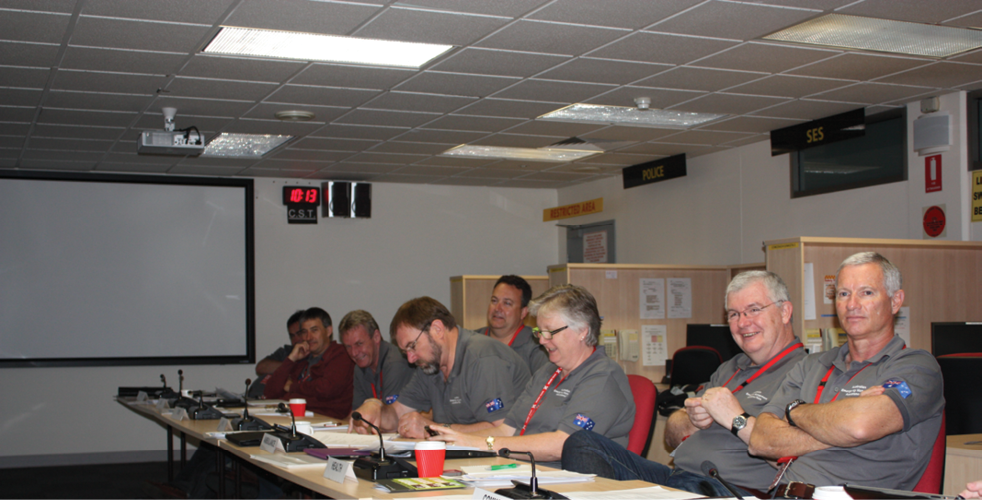
Following the 2011 Queensland floods and cyclones, Emergency Management Australia (EMA), in consultation with Emergency Management Queensland (EMQ), developed an Emergency Management Assistance Team (EMAT) concept. EMAT is comprised of experienced emergency management personnel from Australian states and territories who can rapidly deploy to support emergency management operations across all hazards events.
Disasters have the potential to stretch the operational capacity of emergency management agencies and personnel during heightened times of crisis. Over the course of the 2011 Queensland floods and cyclones, EMQ carried out a sustained period of operational duties. The scope, magnitude and duration of the operation began to stretch the capacity of EMQ personnel. EMQ subsequently requested that EMA identify and deploy experienced emergency management personnel who could provide operational support to the Queensland State Disaster Coordination Centre. EMA responded and deployed highly-skilled emergency management practitioners from different states and territories to assist.
Following the event, EMA and EMQ discussed the benefits of establishing a pool of emergency management personnel who have a comprehensive understanding of emergency management arrangements across Australia. The lessons learned from the 2011 Queensland floods and cyclones identified the need to develop capability that could enhance emergency management sector interoperability and augment operational capabilities during an event.
The initial EMAT Working Group, agreed to by all states and territories, met in June 2012 in Canberra. Emergency management representatives from each state and territory participated in the meeting. Participants explored options for the development of a flexible EMAT Strategy that could address both current and emerging threats.
Discussions from the meeting informed the inaugural EMAT Capability Development Workshop held in September 2012 in Sydney. Workshop participants gained an understanding of emergency management arrangements across Australia and how to quickly assimilate into jurisdictional teams during a deployment. Working Group members also delivered presentations on their jurisdictional arrangements. Presentation material covered issues including state/territory emergency management arrangements, typical risks, likely major activations, key planning and co-ordination considerations, historical events, and possible applications for EMAT.
The EMAT capability consists of a network of emergency management personnel who have a high level of experience in disaster planning and co-ordination. They also have an understanding of each state and territory emergency management arrangements and understand the broad diversity of Australia’s emergency management arrangements. EMAT members provide operational support to affected states and territories and associated regions during a significant event.

Image: EMAT
Participants in the EMAT capability workshop.
The EMAT capability supports the growth of interoperability by facilitating networking opportunities. In particular, the EMAT Working Group and workshops provide a platform for collaboration between members. EMAT networking has increased operational awareness and contributed to the development of a consistent approach to emergency management arrangements across Australia. During heightened times of crisis, the EMAT can rapidly deploy emergency management personnel in order to support and sustain disaster management operations. EMAT deployments are also reviewed regularly in order to ensure the continual growth of operational capabilities.
EMAT has already proven its value. In January 2013, ex-tropical Cyclone Oswald and an associated monsoon trough passed over parts of Queensland. The system was considered a severe natural disaster event and generated very heavy rain, strong winds and produced a number of tornadoes. Queensland coastal communities and low lying areas in rural, regional and city locations were significantly impacted with Mundubbera, Eidsvold, Gayndah and Bundaberg amongst the worst affected. In many places, the total rainfall for the system set new records. Due to the scale and complexity of the disaster, EMQ requested that an EMAT be deployed to assist with the operation. EMA, in consultation with EMQ, requested three planning and recovery specialists drawn from the ACT and NSW to be deployed to the Queensland Disaster Coordination Centre to support operational activities.
The second EMAT capability workshop was held in September 2013 in Adelaide. The workshop gave participants a deeper understanding of emergency management arrangements across Australia. EMAT members discussed lessons learned from the initial EMAT deployment and reflected on recent trends within the emergency management sector. Participants also discussed international trends in emergency management surge capacity and how non-operational activities could be used to encourage growth of the EMAT capability.

Image: EMAT
The EMAT capability workshop in progress.
EMAT continues to work closely with Australia’s emergency management sector to ensure the capability remains current with the latest emergency management developments. EMAT capability workshops are planned on an annual basis to ensure information and knowledge remains current with emergency management issues.
Article supplied by the Planning Section, Crisis Coordination Branch of EMA. EMA acknowledges the commitment of the Working Group and EMQ’s leadership in establishing the EMAT. EMA recognises the extensive support received from states and territories to ensure the EMAT aligns with emergency management trends.